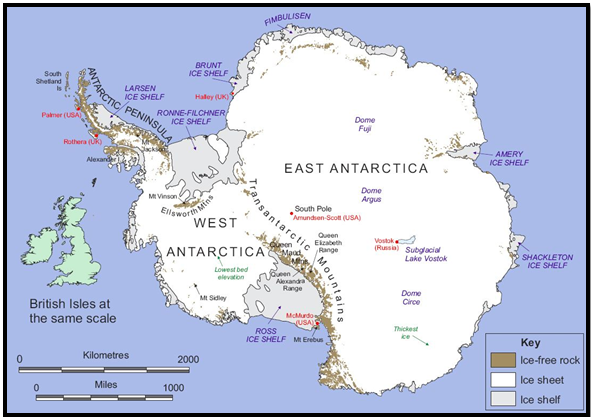BALANCING TOURISM AND CONSERVATION: THE CHALLENGE OF REGULATING ANTARCTIC TRAVEL
Syllabus:
- GS-2- Antarctica and the tourism therein , Prospects and challenges of such tourism
Focus :
- The article focuses on the complexities and challenges of regulating Antarctic tourism, highlighting the dramatic surge in visitor numbers, environmental impacts, and the fragmented governance framework. It underscores the need for stronger international cooperation and science-based decision-making to protect Antarctica’s pristine environment while balancing the benefits of responsible tourism.
Source - TET
Introduction
- The 46th Antarctic Treaty Consultative Meeting (ATCM-46) held in Kochi, Kerala, highlighted the ongoing debate on Antarctic tourism but fell short of providing a definitive regulatory solution.
- The meeting underscored the complexities of managing tourism in Antarctica, a region governed by international consensus and facing rapid environmental changes.
- The debate reflects the challenges of balancing tourism with environmental protection and scientific research in a fragile ecosystem.
Surge in Antarctic Tourism
- Since the early 1990s, the number of tourists visiting Antarctica has surged dramatically, from a few thousand to over 100,000 in the 2022-23 season.
- The International Association of Antarctica Tour Operators (IAATO) estimates 118,089 tourists for the 2023-2024 season.
- The United States and China account for more than 40% of the tourists visiting Antarctica.
- The growth in tourism is driven by increased interest in adventure travel and experiencing Antarctica’s unique landscapes and wildlife.
- Tourists typically embark on multi-day expeditions on small to medium-sized ships, with some opting for larger cruises or fly-sail operations.
Environmental and Economic Impacts
- Antarctic tourism offers educational and economic benefits but raises significant environmental concerns.
- Increased human presence disrupts wildlife, damages fragile ecosystems, and risks introducing invasive species.
- Ship traffic pollutes pristine waters, and tourism adds to the global carbon footprint.
- Climate change exacerbates these issues by opening new areas for tourism while increasing ecosystem vulnerability.
- The balance between scientific research, responsible tourism, and environmental protection is under intense pressure.
Gaps in the Regulatory Framework
- The current governance framework for Antarctic tourism is fragmented and lacks clear regulations.
- The Antarctic Treaty, which came into force in 1961, prioritizes peaceful use and scientific research.
- The Madrid Protocol offers broad environmental guidelines but lacks specific tourism regulations.
- The responsibility for day-to-day management falls largely on IAATO, a self-regulatory industry body.
- Many believe IAATO’s guidelines are inadequate to address the growing environmental pressures.
Challenges in Reaching Consensus
- The ATCM is the primary platform for international cooperation on Antarctic issues but often fails to reach a consensus due to the requirement for unanimous agreement from all consultative parties.
- National interests often impede progress, with some countries pushing for strong regulations while others prioritize economic benefits or interpret Antarctic principles differently.
- The current geopolitical climate further complicates international cooperation on Antarctic governance.
- Despite the limitations, ATCM-46 made some progress by focusing on developing a “comprehensive, flexible, and dynamic” framework for regulating tourism and non-governmental activities.
- A newly established working group will lead this effort over the next year, signifying a renewed commitment to addressing the challenges of Antarctic tourism.
Historical Perspective on Tourism Regulation
- Discussions on tourism regulation have been a point of debate at ATCM meetings since the 1960s.
- A proposed tourism annex introduced in 1991 failed to gain consensus, leading to the current reliance on IAATO’s self-regulation.
- Since a 2004 expert meeting on tourism, discussions have grown more frequent, with concerns encompassing environmental impacts, disruption of research programs, and safety issues.
- The ATCM’s fragmented approach has led to non-binding guidelines rather than comprehensive regulation.
- The limitations of the consensus rule are a recurring theme, allowing activities to continue unregulated in the absence of a clear framework.
India’s Position and Actions
- At ATCM-44 in 2022, India raised concerns about tourism’s impact on Antarctic research, conservation, and the environment.
- Resolution 5 (2022) advised against building tourism-related structures with significant environmental impacts.
- India emphasized the importance of monitoring the impacts of tourism and called for a comprehensive debate on the issue.
- Between ATCM-44 and ATCM-45, a 2023 workshop highlighted the need for governance action on Antarctic tourism.
- Despite the lack of international consensus, India enacted its own Antarctic Law in 2022 to address tourism issues.
Moving Forward
- Finding a sustainable future for Antarctic tourism requires a multi-pronged approach, including strengthening environmental protection, implementing robust monitoring programs, and fostering international cooperation.
- Prioritizing science-based decision-making and engaging all stakeholders are crucial steps.
- The recent efforts at ATCM-46 offer a glimmer of hope for more effective regulation and management of tourism in Antarctica.
- By ensuring that Antarctica remains a pristine wilderness for generations to come, responsible tourism can still offer educational and economic benefits without compromising the region’s environmental integrity.
Source:The Hindu
Associated Article :
https://universalinstitutions.com/india-to-propose-new-antarctic-research-station-at-treaty-meeting/
Mains Practice Question :
GS-2
“Discuss the challenges and opportunities associated with the surge in Antarctic tourism. Evaluate the effectiveness of the current international regulatory frameworks in balancing environmental protection, scientific research, and tourism. What steps can be taken to ensure sustainable tourism in Antarctica?.”(250 words)




